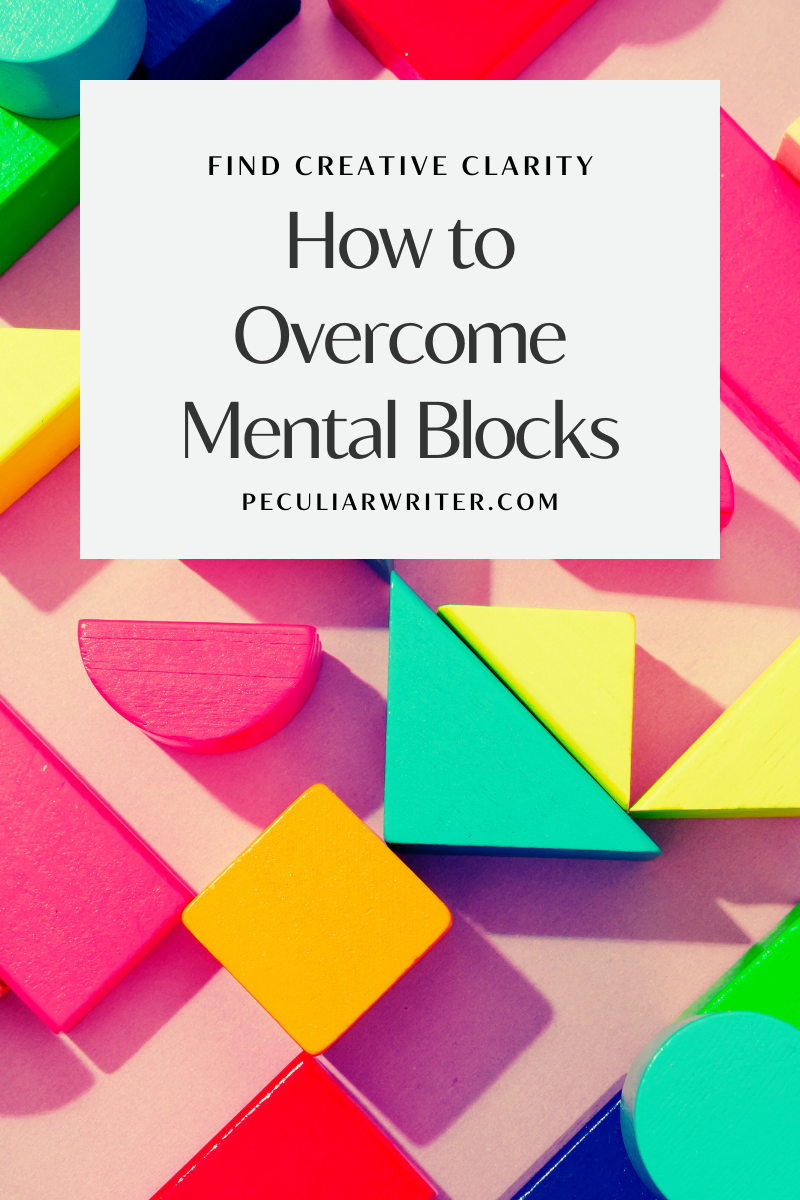
How to Break Free from Mental Blocks and Find Creative Clarity
I had a plan—a big, ambitious, borderline ridiculous plan.
At first, it felt like a creative adrenaline rush. Words flowed and ideas stacked up as I challenged myself to blog every single day for a year. I convinced myself that this relentless consistency would unlock some hidden level of mastery.
Boy, was I wrong!
Instead of feeling accomplished, I felt stuck. Instead of clarity, I had mental fog. And instead of building momentum, I avoided the work I was supposed to be doing.
That’s the thing about mental blocks—they never show up as a flashing “Error 404: Motivation Not Found” sign. They disguise themselves as procrastination, perfectionism, and overcommitment. They trick you into believing you’re making progress when, in reality, you’re wasting energy just spinning your wheels.
After two months of stepping away—unintentionally, thanks to flu season, the holidays, and life happening—I realized my mistake. My daily blogging held me back.

What Created The Mental Blocks
Mental blocks slowly tighten their grip until you can’t move forward at all.
At first, they’re easy to ignore because they disguise themselves as overcommitment and even productivity. You tell yourself, ‘This is just a busy season of life,’ thinking it’ll be fine on the other side. But instead of momentum, there’s no real progress.
Before you know it, you’re stuck—and no amount of “just keep going” will fix it.
When I finally took a step back, I realized my mental block was a result of doubt and avoidance, which led me to three key mistakes.
#1: The Perfectionist Trap (Fear of Failure)
At first, I thought daily blogging would build confidence, but instead, it did the opposite. The more I wrote, the more I doubted whether my work was “good enough.”
Sure, I was posting daily without any care for having the “perfect” blog post. SEO has changed a lot, after all.
But the real fear was that I wasn’t mentally ready for the bigger things—like writing my first course and growing my business. Blogging was safe.
Launching something bigger meant real stakes, real expectations, and the possibility of failing.
#2: Procrastination (a.k.a. Procrasti-Blogging)
You know when you convince yourself that you’re busy and productive, but you’re actually, you know… avoiding the thing you should be doing?
Blogging every day made me feel productive—like I was making progress. But in reality, it became my excuse to put off the hard stuff.
Instead of finalizing my course and figuring out how to market it, I kept churned out posts, as if writing more words would somehow give me the clarity I needed.
It didn’t.
#3: Negative Self-Talk (“If I Can Do This, I Can Do That… Right?”)
This one was sneaky. It seemed like positive thinking at first: If I can blog daily, I can totally write a course. If I can be consistent here, I can do it anywhere.
But, it was just mental gymnastics. Honestly, blogging felt safer than making big decisions, so I kept convincing myself that I was “preparing” instead of just taking action.
That mindset kept me stuck in a loop. Instead of doing the thing, I kept adding more steps between me and the goal.
But mental blocks don’t mean we’re lazy or incapable.
Why Mental Blocks Happen
Our brains are wired to avoid discomfort and uncertainty.
Our brains default to self-preservation mode, looking for the path of least resistance whenever we make big decisions or take a risk. We cling to what feels familiar—whether that’s reworking the same ideas, endlessly researching, or filling our time with easier tasks that create the illusion of progress. This avoidance builds into a full-blown mental traffic jam.
This makes it harder and harder to move forward.
Once I recognized this pattern in myself, I realized my mental block had nothing to do with my ability.
Let’s get more specific about this.
Feeling Stuck = Self-Doubt
At its core, feeling stuck is a lack of belief.
Even though I had experience, a clear business plan, and knowledge, I kept telling myself I needed more practice, more preparation, more proof that I was capable. Blogging became my safety net—a way to stay productive without actually taking the next leap.
Waiting until you “feel ready” is a never-ending trap. The more you delay action, the more your brain collects evidence that you’re not capable.
Read that last sentence again.
Lack of Inspiration = Analysis Paralysis
Ironically, even though I had a clear outline for my course, I felt uninspired to write it. I was stuck because I researched too much and over-prepared.
I had a flood of information to sift through—research, client insights, past content—and instead of making it easier, it made doing the thing overwhelming.
When you’re trying to process everything at once, your brain freezes up. You start second-guessing every decision, questioning what’s most important, and before you know it, you’re stuck in analysis paralysis.
Too much input leads to inaction.
Avoiding Hard Decisions
Blogging isn’t easy, but it was a means to avoid harder work. And I was avoiding making hard decisions on marketing something I created by myself instead of doing it with a client and their team.
The hardest part of growth isn’t doing the work—it’s committing to the decisions that come with it. And when you avoid those decisions, you stay busy with what’s comfortable, convincing yourself that you’re moving forward when really, you’re just treading water.
Luckily, mental blocks aren’t permanent once you recognize the patterns.
Mindset Shifts
Mental blocks don’t just disappear on their own—you have to dismantle them with intentional action and mindset shifts.
If you wait for motivation to return, you’ll stay stuck in the same cycles. Breaking free isn’t doing more—it’s doing differently. And doing differently requires restructuring your approach to make goals achievable.
Which is why you have to stop forcing progress.
This is how I realigned my priorities and sustainably rebuilt my creative energy:
#1: Take a Break (Or be forced to take one)
At first, I didn’t choose to take a break—life chose for me. Between flu season, the holidays, and life, I was forced to step away from my daily grind.
And that’s when I realized…
Distance gives you clarity.
When you’re in the thick of a mental block, every problem feels urgent. You push until you burn. So, pause and step back, you create space for new insights to come through.
And if you’re like me, instead of seeing breaks as lost time, I started seeing them as part of the creative process.
Rest is a strategy.
#2: Break Down Tasks & Set Realistic Expectations
One of the biggest reasons I felt stuck was because I saw my course as one massive, overwhelming project. My brain treated it like an impossible-to-climb mountain, so I kept avoiding it.
By chunking it down into micro-goals, it became doable.
Instead of thinking, I have to write an entire course, I focused on:
✔ Creating the welcome section.
✔ Writing one lesson from one module at a time.
✔ Completing just one email from one automation at a time.
This simple mindset shift turned Goliath-sized tasks into manageable steps.
Once you start, momentum follows.
#3: Change Your Routine
I’d heard about Amy Porterfield’s “Tiger Time”, where you block out non-negotiable time for deep work.
But I needed something that fit my creative energy, so I reframed it into two distinct blocks:
🐉 Dragon Time (Morning) → Uninterrupted, high-focus time for MY work (course writing, big-picture strategy, blogs, emails, etc.).
And I gave each day of the week a theme so I knew exactly what to do without overthinking it. For a month, I left course writing as my default. Now, I have:
→ ‘writing a blog’ on Mondays,
→ ‘writing emails’ on Tuesdays & Fridays,
→ ‘create supporting content’ on Thursdays, and
→ ‘review and scheduling’ on Wednesdays.
I leave the weekends for an upcoming book I’m writing.
🐅 Tiger Time (Afternoon) → Focused time for client work after a mental and creative reset.
And just like Dragon Time, I break it down into themes for each day of the week (except weekends and holidays).
Why this worked:
Dragon Time = first-thing-in-the-morning, creative peak energy before life gets busy.
Tiger Time = structured deep work after I’ve handled personal priorities and recharged.
Prevents mental exhaustion from bouncing between projects all day.
This small shift completely changed my workflow, making my work feel lighter, more focused, and actually doable.
Moving Forward
Mental blocks don’t disappear overnight. They unravel when you stop forcing progress and start creating the conditions for it.
For me, that meant stepping back, restructuring my approach, and shifting my expectations.
As a result, I finally finished writing my course. I also realigned my priorities, which has been refreshing. And I’m stepping back into blogging with a plan that actually works—posting once a week instead of daily.
If you’ve been feeling stuck, overwhelmed, or trapped in your own mental block try taking a step back instead of pushing forward. You might find that the clarity you need comes when you finally stop chasing it.

